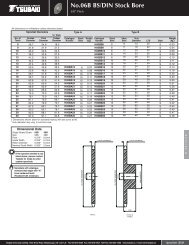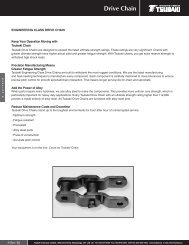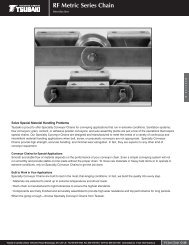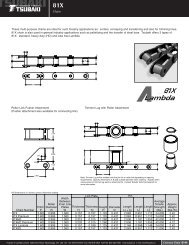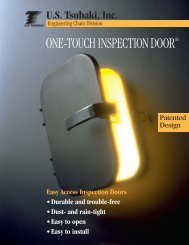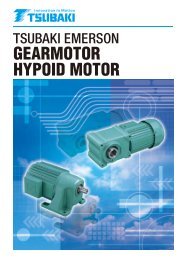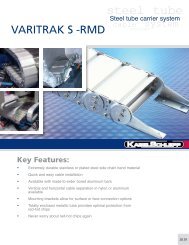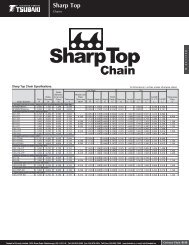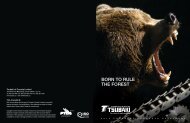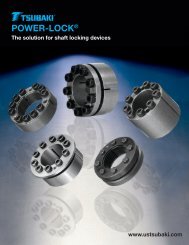Roller Chain - Tsubaki
Roller Chain - Tsubaki
Roller Chain - Tsubaki
You also want an ePaper? Increase the reach of your titles
YUMPU automatically turns print PDFs into web optimized ePapers that Google loves.
Drive <strong>Chain</strong> SelectionDesign chain tension F’b = Fb × Kv × Kc × Ku= 8937 × 1.02 × 1.28 × 0.6= 7000 lbs……………………Design chain tension F’b = Fb × Kv × Kc × Ku= 4054 × 1.02 × 1.28 × 0.63 = 3176 (kgf) ………………….. 3When comparing the calculated design chain tensions in Steps q, w, and e, note that F b in Step e is the greatest.Drive <strong>Chain</strong>Comparing F’b (7000lbs) with the maximum allowableload of SUPER 120 chain (8818lbs), F’b < 8818lbsTherefore, this chain may be selected.The drive chain isdF’b × = 7000 ×d’6.7411.959Comparing F’b (3176 kgf) with the maximum allowableload of SUPER 120 chain (4000 kgf), F’b < 4000 kgf.Therefore, this chain may be selected.The drive chain isdF’b × = 3176 × 171.22d’303.75= 3945 lbs < 6834 lbsThis value is less than the maximum allowableload of SUPER 100 chain, so it may also be used.= 1790 kgf < 3100 kgfThis value is less than the maximum allowableload of SUPER 100 chain, so it may also be used.(Conclusion)It is possible to use SUPER 120 for lifting applications and SUPER 100 for drive applications. However, if operational restrictions occurdue to overload, the chains will be subjected to the following loads: Drive chain: Fd = 52.08 × 12 × 60 × 2 = 13,814 (6266 kgf) (perstrand), Fd × Ku = 13814lbs × 0.6 = 8284lbs (3757 kgf), Lifting chain: Fd × 11.959 5.617= 14,692lbs (6,664 kgf).6.741In this case, since there is a possibility of chain plastic deformation, increase the chain size by selecting SUPER 120-2 for liftingtransmission and SUPER 120 for drive transmission, just to be safe.Weight required in lifting transmission applications for counterweight to prevent roller chain from climbingor jumping sprocket teeth.Tk = To × {sin 0/sin (0+ 2α)} K–1θ : <strong>Chain</strong> wrapping angleTk : Minimum weight tension (Minimum back-tension)To : <strong>Roller</strong> <strong>Chain</strong> tension0 : Sprocket minimum pressure angle 0 = 17° – 64°N2α : Sprocket dividing angle 2α =360°Nθ Round-up to the nearestK : Engaging No. of teeth K = × N …360° whole number to be safe.ToN: No. ofteethWeightImperial EquationIf To = 2425 lbs, N = 13 T , and θ = 120°, then0 = 17°–64°= 17° –64°= 12.077N 13360° 360°2α = = = 27.692N 13θ 120°K = × N = × 13 = 4.33 … K = 4360° 360°Tk = 2425 × {sin12.077/sin (12.077 + 27.692)} 4–1 = 85 (lbs)Metric EquationIf To = 1100 kgf, N = 13 T , and θ = 120°, then0 = 17°–64°= 17° –64°= 12.077N 13360° 360°2α = = = 27.692N 13θ 120°K = × N = × 13 = 4.33 … K = 4360° 360°Tk = 1100 × {sin12.077/sin (12.077 + 27.692)} 4–1 = 38.5 (kg)A-104Therefore, the roller chain will not climb or jump sprocket teeth if a 39 kg (85lbs) weight is used. However, this will change depending on the layout andamount of wear on the <strong>Roller</strong> <strong>Chain</strong> and sprocket teeth. Please use the aboveas a reference.



